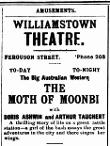 4723327029572794953.jpg
4723327029572794953.jpg
 4723327029572794953.jpg
4723327029572794953.jpg
'Charles Chauvel's first feature tells the story of a country girl, Dell Ferris (the Moth of Moonbi), drawn to the bright lights of the big city where her inheritance is soon frittered away with high society revelling. A wiser Dell returns to Moonbi Station where she is beset by the cattle rustler Jack Bronson, but finally finds peace and happiness with the faithful head stockman, Tom.
Shot on location in the bush outside Brisbane the film was also made at an improvised studio at the rear of a guest house in the city. Despite cold weather, cast and crew camped out with pack-horses and sheep for fresh meat. This first effort of Chauvel's (he appears in the film in blackface as an Aboriginal stockman) showed signs of the action director's career characteristics. He shot on difficult locations with new acting talent and told an Australian story which gave heroic dimensions to ordinary lives. Scenes of station life are authentic pictures of cattle yards, transportation by train, and the sale yards. The production cost 4400 pounds and was released at the Wintergarden Theatre, Brisbane on 25 January 1926' (National Film and Sound Archive).
 Featuring Australia : The Cinema of Charles Chauvel
Sydney
:
Allen and Unwin
,
1991
Z808336
1991
single work
biography
Featuring Australia : The Cinema of Charles Chauvel
Sydney
:
Allen and Unwin
,
1991
Z808336
1991
single work
biography